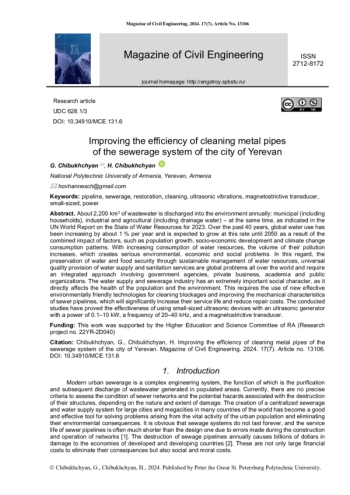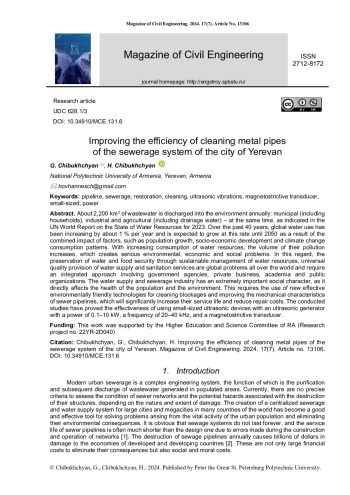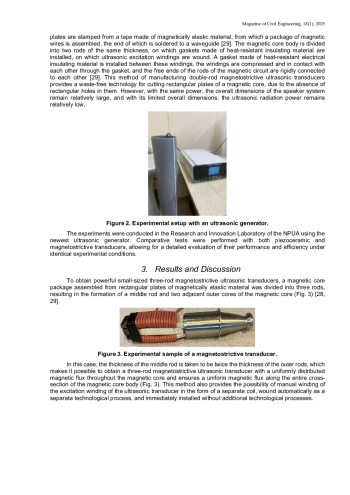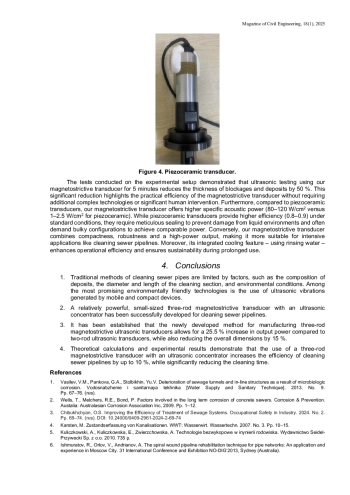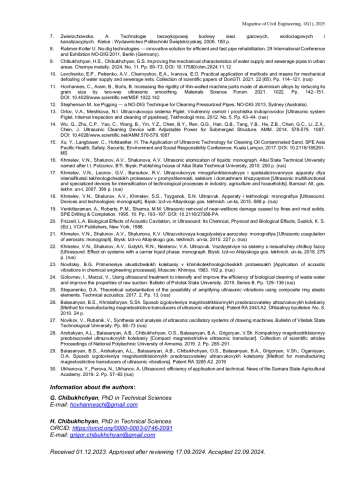About 2,200 km3 of wastewater is discharged into the environment annually: municipal (including households), industrial and agricultural (including drainage water) – at the same time, as indicated in the UN World Report on the State of Water Resources for 2023. Over the past 40 years, global water use has been increasing by about 1 % per year and is expected to grow at this rate until 2050 as a result of the combined impact of factors, such as population growth, socio-economic development and climate change consumption patterns. With increasing consumption of water resources, the volume of their pollution increases, which creates serious environmental, economic and social problems. In this regard, the preservation of water and food security through sustainable management of water resources, universal quality provision of water supply and sanitation services are global problems all over the world and require an integrated approach involving government agencies, private business, academia and public organizations. The water supply and sewerage industry has an extremely important social character, as it directly affects the health of the population and the environment. This requires the use of new effective environmentally friendly technologies for cleaning blockages and improving the mechanical characteristics of sewer pipelines, which will significantly increase their service life and reduce repair costs. The conducted studies have proved the effectiveness of using small-sized ultrasonic devices with an ultrasonic generator with a power of 0.1–10 kW, a frequency of 20–40 kHz, and a magnetostrictive transducer.
Идентификаторы и классификаторы
Modern urban sewerage is a complex engineering system, the function of which is the purification and subsequent discharge of wastewater generated in populated areas. Currently, there are no precise criteria to assess the condition of sewer networks and the potential hazards associated with the destruction of their structures, depending on the nature and extent of damage. The creation of a centralized sewerage and water supply system for large cities and megacities in many countries of the world has become a good and effective tool for solving problems arising from the vital activity of the urban population and eliminating their environmental consequences. It is obvious that sewage systems do not last forever, and the service life of sewer pipelines is often much shorter than the design one due to errors made during the construction and operation of networks [1]. The destruction of sewage pipelines annually causes billions of dollars in damage to the economies of developed and developing countries [2]. These are not only large financial costs to eliminate their consequences but also social and moral costs.
Список литературы
1. Vasilev, V.M., Pankova, G.A., Stolbikhin, Yu.V. Deterioration of sewage tunnels and in-line structures as a result of microbiologic corrosion. Vodosnabzhenie i sanitarnaya tekhnika [Water Supply and Sanitary Technique]. 2013. No. 9. Pp. 67–76. (rus).
2. Wells, T., Melchers, R.E., Bond, P. Factors involved in the long term corrosion of concrete sewers. Corrosion & Prevention. Austalia: Australasian Corrosion Association Inc, 2009. Pp. 1–12.
3. Chibukhchyan, O.S. Improving the Efficiency of Treatment of Sewage Systems. Occupational Safety in Industry. 2024. No. 2. Pp. 69–74. (rus). DOI: 10.24000/0409-2961-2024-2-69-74
4. Karsten, M. Zustandserfassung von Kanalisationen. WWT: Wasserwirt. Wassertechn. 2007. No. 3. Pp. 10–15.
5. Kuliczkowski, A., Kuliczkowska, E., Zwierzchowska, A. Technologie bezwykopowe w inynierii rodowiska. Wydawnictwo Seidel-Przywecki Sp. z o.o. 2010. 735 p.
6. Ishmuratov, R., Orlov, V., Andrianov, A. The spiral wound pipeline rehabilitation technique for pipe networks: An application and experience in Moscow City. 31 International Conference and Exhibition NO-DIG’2013, Sydney (Australia).
7. Zwierzchowska, A. Technologie bezwykopowej budowy sieci gazowych, wodociagowych i kanalizacyjnych. Kielce : Wydawnictwo Politechniki Świętokrzyskiej, 2006. 180 p.
8. Rabmer-Koller U. No-dig technologies — innovative solution for efficient and fast pipe rehabilitation. 29 International Conference and Exhibition NO-DIG’2011, Berlin (Germany).
9. Chibukhchyan, H.S., Chibukhchyan, G.S. Improving the mechanical characteristics of water supply and sewerage pipes in urban areas. Chernye metally. 2024. No. 11. Pp. 69–73. DOI: 10.17580/chm.2024.11.12
10. Levchenko, E.P., Petrenko, A.V., Chernyshov, E.A., Ivanova, E.O. Practical application of methods and means for mechanical defouling of water supply and sewerage nets. Collection of scientific papers of DonGTI. 2021. 22 (65). Pp. 114–121. (rus)
11. Hovhannes, C., Aram, B., Boris, B. Increasing the rigidity of thin-walled machine parts made of aluminium alloys by reducing its grain size by two-way ultrasonic smoothing. Materials Science Forum. 2021. 1022. Pp. 142–151. DOI: 10.4028/www.scientific.net/MSF.1022.142
12. Stephenson M. Ice Pigging — a NO-DIG Technique for Cleaning Pressurized Pipes. NO-DIG 2013, Sydney (Australia).
13. Orlov, V.A., Meshkova, N.I. Ultrazvukovaya sistema Piglet. Vnutrenniy osmotr i prochistka truboprovodov [Ultrasonic system Piglet. Internal inspection and cleaning of pipelines]. Tekhnologii mira. 2012. No. 5. Pp. 43–44. (rus)
14. Wu, Q., Zhu, C.P., Yao, C., Wang, B., Yin, Y.Z., Chen, B.Y., Ren, Q.G., Han, Q.B., Tang, Y.B., He, Z.B., Chen, G.C., Li, Z.X., Chen, J. Ultrasonic Cleaning Device with Adjustable Power for Submerged Structure. AMM. 2014. 578-579. 1087. DOI: 10.4028/www.scientific.net/AMM.578-579.1087
15. Xu, Y., Langbauer, C., Hofstaetter, H. The Application of Ultrasonic Technology for Cleaning Oil Contaminated Sand. SPE Asia Pacific Health, Safety, Security, Environment and Social Responsibility Conference. Kuala Lumpur, 2017. DOI: 10.2118/185261-MS
16. Khmelev, V.N., Shalunov, A.V., Shalunova, A.V. Ultrasonic atomization of liquids: monograph. Altai State Technical University named after I.I. Polzunov, BTI. Biysk: Publishing house of Altai State Technical University, 2010. 250 p. (rus)
17. Khmelev, V.N., Leonov, G.V., Barsukov, R.V. Ultrazvukovyye mnogofunktsionalnyye i spetsializirovannyye apparaty dlya intensifikatsii tekhnologicheskikh protsessov v promyshlennosti, selskom i domashnem khozyaystve [Ultrasonic multifunctional and specialized devices for intensification of technological processes in industry, agriculture and households]. Barnaul: Alt. gos. tekhn. un-t, 2007. 399 p. (rus)
18. Khmelev, V.N., Shalunov, A.V., Khmelev, S.S., Tsyganok, S.N. Ultrazvuk. Apparaty i tekhnologii: monografiya [Ultrasound. Devices and technologies: monograph]. Biysk: Izd-vo Altayskogo gos. tekhnich. un-ta, 2015. 688 p. (rus)
19. Venkittaraman, A., Roberts, P.M., Sharma, M.M. Ultrasonic removal of near-wellbore damage caused by fines and mud solids. SPE Drilling & Completion. 1995. 10. Pp. 193–197. DOI: 10.2118/27388-PA
20. Frizzell, L.A. Biological Effects of Acoustic Cavitation, in Ultrasound: Its Chemical, Physical and Biological Effects, Suslick, K. S. (Ed.), VCH Publishers, New York, 1988.
21. Khmelev, V.N., Shalunov, A.V., Shalunova, K.V. Ultrazvukovaya koagulyatsiya aerozoley: monografiya [Ultrasonic coagulation of aerosols: monograph]. Biysk: Izd-vo Altayskogo gos. tekhnich. un-ta, 2010. 227 p. (rus)
22. Khmelev, V.N., Shalunov, A.V., Golykh, R.N., Nesterov, V.A. Ultrazvuk. Vozdeystviye na sistemy s nesushchey zhidkoy fazoy [Ultrasound. Effect on systems with a carrier liquid phase: monograph. Biysk: Izd-vo Altayskogo gos. tekhnich. un-ta, 2018. 275 p. (rus)
23. Novitskiy, B.G. Primeneniye akusticheskikh kolebaniy v khimikotekhnologicheskikh protsessakh [Application of acoustic vibrations in chemical engineering processes]. Moscow: Khimiya, 1983. 192 p. (rus)
24. Golovnev, I., Marzul, V., Using ultrasound treatment to intensify and improve the efficiency of biological cleaning of waste water and improve the properties of raw suction. Bulletin of Polotsk State University. 2019. Series B. Pp. 129–136 (rus)
25. Stepanenko, D.A. Theoretical substantiation of the possibility of amplifying ultrasonic vibrations using composite ring elastic elements. Technical acoustics. 2017. 2. Pp. 13. (rus)
26. Balasanyan, B.S., Khristaforyan, S.Sh. Sposob izgotovleniya magnitostriktsionnykh preobrazovateley ultrazvukovykh kolebaniy [Method for manufacturing magnetostrictive transducers of ultrasonic vibrations]. Patent RA 2443 A2. Ofitsialnyy byulleten. No. 8. 2010. 24 p.
27. Novikov, V., Rubanik, V., Synthesis and analysis of ultrasonic oscillatory systems of drawing machines. Bulletin of Vitebsk State Technological University. Pp. 68–73 (rus)
28. Arshakyan, A.L., Balasanyan, A.B., Chibukhchyan, O.S., Balasanyan, B.A., Grigoryan, V.Sh. Kompaktnyy magnitostriktsionnyy preobrazovatel ultrazvukovykh kolebaniy [Compact magnetostrictive ultrasonic transducer]. Collection of scientific articles Proceedings of National Polytechnic University of Armenia. 2019. 2. Pp. 285–291.
29. Balasanyan, B.S., Arshakyan, A.L., Balasanyan, A.B., Chibukhchyan, O.S., Balasanyan, B.A., Grigoryan, V.Sh., Oganisyan, O.A. Sposob izgotovleniya magnitostriktsionnykh preobrazovateley ultrazvukovykh kolebaniy [Method for manufacturing magnetostrictive transducers of ultrasonic vibrations]. Patent RA 3265 A2. 2019
30. Ukhanova, Y., Perova, N., Ukhanov, A. Ultrasound: efficiency of application and technical. News of the Samara State Agricultural Academy. 2019. 2. Pp. 57–63 (rus)
Выпуск
Другие статьи выпуска
The work is devoted to the study and analysis of hydrodynamic and climatic loads on hydraulic structures of the Neva Bay – the eastern part of the Gulf of Finland, which is exposed to significant anthropogenic and natural impacts. The geographical position of the Neva Bay, as well as the complex of flood protection structures of St. Petersburg, affect the predicted load levels. In these conditions, special attention is paid to the design and operation of pontoons and other hydraulic structures resistant to waves, ice cover and wind loads. The study calculated the wave-protective characteristics and stability of pontoons used in the Neva Bay as moorings for small vessels. The main parameters of wave loads were estimated using wave models, which made it possible to take into account irregular water oscillations and their effect on the dynamic behavior of structures. A test was carried out for the stability of pontoons with various configurations of anchor systems that ensure their fixation at a given point in the water area. The simulation showed that under conditions of irregular waves and changing water levels, floating structures experience significant loads that are distributed to the anchor system and require accurate calculations to ensure reliability. Additionally, ice and wind load on hydraulic structures, loads associated with thermal expansion of ice, changes in water levels, and wind effects were studied, taking into account the characteristics of ships of different lengths and above-water heights. The simulation results make it possible to identify key operating conditions for protective and berthing structures in the Neva Bay and provide information for inclusion in the information model of the water area, which will allow predicting the behavior of structures under changing natural and climatic conditions.
The paper studies the ways that technological characteristics of thermal wood concrete (TWC) production have on its strength and thermal conductivity properties. TWC is a new, effective wood-cement composition of authors’ development. To produce it the authors used crushed thermally modified wood (TMW) with a certain shape and size as a filler. The research is rationalized by the fact that currently we are facing a lack of both fundamental and applied experimentally confirmed data on TWC. The paper discusses the studies of the compressive strength and thermal conductivity of four groups of TWC samples that were obtained with three types of filler, differing in size and shape, molding method and strength class of cement-sand mortar. The authors determined general impact patterns of the above-mentioned factors on strength and thermal conductivity properties, as well as specific indicators. Moreover, the paper describes the strength classes and grades of TWC that ranged from B1.5 to B3.5 and from M25 to M50, respectively. Thermal conductivity for standard samples ranged from 0.21 to 0.4 W/(mK). It has been concluded that TWC with a finer TMW filler has the most balanced combination of strength, thermal conductivity and deformation properties. Following the results, the authors proposed practical recommendations for TWC production, and further courses for its improvement and research.
Chemical stabilization is a typical method for enhancing salinity in soils. In this regard, an effort has been made to evaluate the effect of chemical substances and stabilizers of Portland cement on the geotechnical characteristics of salt soils. Due to their geologic makeup, textural characteristics, and climatic factors, the majority of the soils in the southern part of Iraq are notable for having a wide variety of formations. Because the soil particles in the saline regions of Thi-Qar governorate are encircled by molecules of chlorides, sulfates, or other salt species that function as link agents to fill in the gaps in the dry state, these soils may generally be categorized as saline soils. The sort of salt in such soil determines how it should be disposed of. The objective of this study is to investigate the effect of adding different types of salt compounds including NaCl, MgCl2, Na2SiO3, and CaCl2 with various percentages 2, 4, 8, and 10 % and Portland cement for improving the consistency limits and shear strength of saline soft soils. It was found that adding cement materials and a group of chlorides NaCl, MgCl2, Na2SiO3, and CaCl2 increased the unconfined compressive strength of the soil from 290 to 814, 506, 404, 574, and 422 kPa, respectively, and decrease the consistency limits.
The requirements for reliability and durability are increasing every year for the critical elements of bridge structures, as there is a steady increase in the number of vehicles and volumes of cargo movement. Such structural elements include bearing parts of spans of bridges, which perceive loads from the mass of spans, transport cargo and compensate for deformations from thermal expansion and contraction. Antifriction polymeric materials are used in all newly developed designs of bearing parts. The reliability and durability of bridges as a whole depend on the physical, mechanical and operational properties of such materials. The change in the length of spans due to temperature fluctuations is carried out due to sliding along the polymer layers. The article presents a critical analysis of the polymer and metal-polymer materials used as sliding supports. A review and analysis of standardized anti-friction materials for possible use as sliding layers in the bearing parts of bridges have been carried out. The most promising fluoroplastic composite materials capable of operating without lubricant are presented. An analysis of metal-fluoroplastic sheet materials was made, new metal composites were proposed, in which various mesh materials with a high polymer content in the working layer are used as an anti-friction layer. Such materials can be used as guides for the moving bearing parts of the bridge without the use of lubricants. It is shown that the use of the described modern wear-resistant anti-friction materials will significantly increase the bearing capacity and service life of sliding bearings.
Utilization of ground granulated blast furnace slag (GGBFS) and fly ash (FA) to resolve the problem of increasing discharged and total accumulated industrial waste has attracted public concern. This article presents the research results on the effect of the replacement of up to 60 wt.% cement with GGBFS and FA, separately and in combination. It shows that mineral admixtures improve the workability of concrete mixture and reduce the required water-reducing admixture to reach a defined slump, prolonging the setting time of fresh concrete. The compressive strength of concrete with GGBFS at an early age decreases while increasing at 60 days and 90 days with the GGBFS content from 20 wt.% to 40 wt.%. The compressive strength of concrete with FA well develops at a later age, but it decreases at all ages as the FA replacement ratio increases. Cement replacement with a combined mineral admixture of 20 wt.% GGBFS and 20 wt.% FA does not significantly change the compressive strength at 28 days and later. Based on test result
Foam solution discharge is always accompanied by changes in the operating pressure due to different pressure losses along the pipeline in automatic foam extinguishing systems. Changes in the operating pressure affect the process of a liquid jet fragmentation into droplets and the formation of foam films. Therefore, to increase the accuracy of calculations when designing automatic foam extinguishing systems, it is worthwhile to evaluate the main characteristics of the foam in terms of fire extinguishing efficiency, in particular, its expansion. For this purpose, the generalization of the experimental data using the theory of similarity and taking into consideration the hydrodynamic features of the deflector type sprinkler operation and the properties of foam solution was carried out to develop a novel simplified mathematical model. This model allows to predict the foam expansion depending on the geometric parameters of the sprinkler elements and the empirical coefficient, which takes into account the peculiarities of the chemical composition of the foam concentrate. This new model predictions of foam expansion show good agreement with the experimentally measured foam expansion. The average error in foam expansion was less than 9 %.
The paper is devoted to the issues of predicting the temperature distribution in asphalt concrete layers in different periods of the year. Mechanical parameters of asphalt concrete strongly depend on its temperature. The reliability of the temperature dependence used for temperature prediction directly determines the reliability of calculation methods for motorway pavements design. At the same time, it should be noted that many existing models describe the temperature distribution along the depth of the asphalt concrete layer package with a rather large degree of error and are not calibrated for the conditions of the Russian Federation. Methods. The approach proposed by the authors is based on the study of the actual temperature distribution in asphalt concrete pavements by analyzing data from a set of measuring sensors installed at different depths of the asphalt concrete pavement package. The actual temperature distribution was monitored during the annual cycle from March 2023 to April 2024. Results. To approximate the results obtained, a dependence describing the sinusoidal nature of temperature variation on the surface and in the asphalt concrete layers was modified. Modification of the dependence was carried out by introducing an additional empirical parameter characterizing the dependence of the change in the absolute temperature value on the depth. The accuracy of the modified dependence is confirmed by the root mean square error (RMSE) value of up to 10 %. Conclusions. The model modified in the paper can be used at the stage of design and operation of motorways when calculating the temperature conditions of asphalt concrete layers.
Статистика статьи
Статистика просмотров за 2025 - 2026 год.
Издательство
- Издательство
- Политех
- Регион
- Россия, Санкт-Петербург
- Почтовый адрес
- 195251, г.Санкт-Петербург, ул. Политехническая, дом 29
- Юр. адрес
- 195251, г Санкт-Петербург, Калининский р-н, ул Политехническая, д 29 литера б
- ФИО
- Рудской Андрей Иванович (РЕКТОР)
- E-mail адрес
- office@spbstu.ru
- Контактный телефон
- +7 (812) 2972077
- Сайт
- https://spbstu.ru
